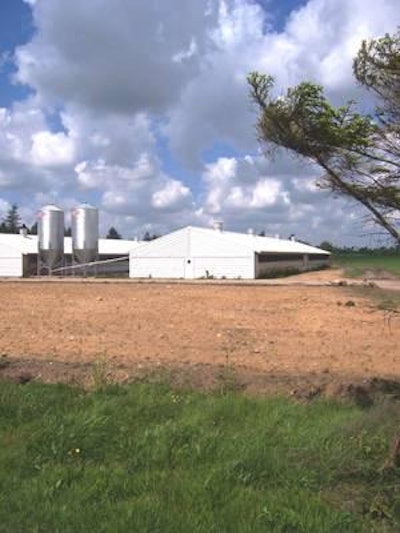
Work at the University of Minnesota Center for Farm Financial Management shows US finishing units can incur fuel/oil expenses of 71 cents per pig compared with 49 cents/pig for producers of weaned pigs.
Heating expense can be excessive where the ventilation runs at the wrong rate or the temperature setting is wrong. Even small mistakes can make a significant difference to energy use.
One mistake is to believe that setting the ventilation control panel to 50% necessarily means that the fan or fans will run at half of their rated capacity. Small variable-speed fans generally give 50% of rated output at 65-70% of their rated top speed. For bigger fans this can be at 60-65% of maximum speed.
Control panels to regulate variable-speed fans decide on operations in ventilation and heating according to a set-point temperature. A common mistake is to assume the set-point temperature on the panel is the same as the room temperature at the room sensor. Heating will turn off when the room temperature reaches a certain level. To avoid wasting heat, arrange for the heater to switch off when room temperature is 1 degree C below the set-point.
Feed checklist
Of course, one key way to reduce energy use is to maximize feed and water intake. On feed, the Prairie Swine Centre Inc., in Saskatoon, Canada, has developed the following checklist:
Temperature. Too high reduces feed intake, and too low reduces feed efficiency. Feed intake will be reduced by 1% to 2% for every 10 degrees C above the pig’s thermo-neutral comfort zone. Also, reduce nocturnal temperatures in the summer.
Feed and water access. Feeder design and type of feed (mash or pellet) will impact the carrying capacity of the feeder. Feeder performance is maximized when the feeder gap allows for 40% of the trough to be covered with feed, as well as reducing eating time in increasing feeder capacity. In addition, utilizing mash diets and wet/dry feeders can increase feed intake by up to 5%. Ensure that pigs have free access to water. Water intake in growing pigs with free access to feed is about 2.2 to 3.0 times the feed intake. One functioning nipple is required per pen of 12 pigs.
Space allocation. Floor space allowance that maximizes growth rate and feed intake is =0.35m2 x BWO.667. Growth is depressed by 0.5% for every 1% reduction in space allowance below a critical point. Growth rate can be reduced by up to 10% in the last part of the finisher under a crowed scenario. Negative impacts of reduced space on ADG are not corrected by feeding pigs diets with high nutrient density.
Social interaction. Rooms containing variable weight pens empty four to six days sooner than rooms with uniform weight pens. Studies have shown reported mixing pigs two weeks before marketing reduced growth rate by 11%, and subsequent market weights. Mixing may make economic sense when it significantly improves building utilization. (Mixing partially marketed pens of pigs to make room for the next group being transferred into the room.)
Barn entry weight. Bigger pigs eat more feed. As a result, anything that can increase the size of pigs entering the growout will increase feed intake.
Health status. Moderate health issues can reduce feed intake by 5% or more, while severe health problems can reduce feed intake by 15% or more.
Diet composition. Excess minerals, especially calcium may reduce feed intake. Ensuring a proper amino acid balance and energy to amino acid balance is met. Otherwise, feed intake may be adversely impacted. The use of various feed additives may increase feed intake. However, the cost effectiveness of these additives will vary among farms. Increasing levels of energy in diets will increase feed efficiency but not growth rate. As a simple rule of thumb, if the percent increase in DE concentration is greater than the percent increase in diet cost, the increase will pay for itself in terms of feed efficiency.
Anti-nutritional factors. Complete diets containing 1% ergot will reduce pig performance by more than 30%. Choose ingredients with low tannin levels. Tannis are compounds that have the ability to bind to proteins, including dietary protein, thus impairing the ability of the pig to use dietary protein. Tannins also reduce palatability due to a sour taste. The impact of aflatoxin is age and dose dependant, and at low levels (20-200 ppb) ranges from depressed performance to immune suppression. Guidelines for feeding mycotoxin are for Vomatoxin (DON): nursery 0.5 ppm, finisher 1.0 ppm and breeding herd 1.0 ppm.
Energy savings through water intake
For saving energy through optimal water intake, the Centre says:
- Mounting water nipples correctly reduces wasted water.
- Check flow rates. Flow rates determine time spent at the nipple, waster intake and water wastage.
- Use wet/dry feeders in grow-finish. Wet/dry feeders reduce water used by 34% and slurry volume by 20% to 40% compared with dry feeders and a bowl. Wet/dry feeders also increase consumption of mash diets compared to dry feeders and a separate water nipple, resulting in a 5% improvement in average daily gain.
- Feeding diets containing excessive protein and/or excessive mineral levels results in increased water usage.
- Temperature impacts water requirements.
- Water: feed ratios decrease as pigs grow.

















